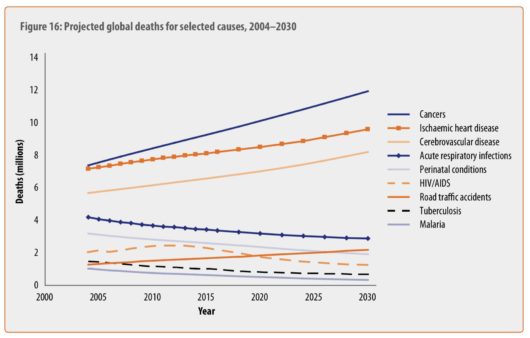Infectious diseases – malaria, TB, typhoid, dysentery, measles – have been the leading cause of human morbidity and mortality throughout history. But today, the burden of infectious diseases has greatly diminished in wealthier countries. In developing nations, infectious diseases remain the leading causes of both death and of DALYs lost, especially among children and young adults. But this lead is rapidly ending.
As nations develop, in terms of education and economy, an epidemiologic transition predictably occurs from a predominance of infectious diseases toward chronic non-infectious, non-communicable diseases. Today coronary artery disease, for example, has risen to among the top causes of DALYs lost in multiple developing nations. The image above shows malaria, pneumonia, and TB continuing to decline over the next 15 years, while cancers, CAD, and stroke climb upward. That latter is closely associated with increases in tobacco abuse and unhealthy diet in these nations, just as in wealthier nations.
What do these developments mean for we in international health? For one, they likely spell a steady end to tropical medicine as an essential skill set. Just like The End of Poverty, the The End of Tropical Medicine will not be an absolute milestone. But in light of modern shifting health needs, leaders and practitioners will need to re-equip and re-prioritize. In 2019, look for new chronic, non-infectious disease content in INMED’s Professional Certificate Courses. These epidemiological developments also mean longer, more illness-free and prosperous life for all humanity, as we steadily celebrate the end of overwhelming emphasis on tropical medicine.

